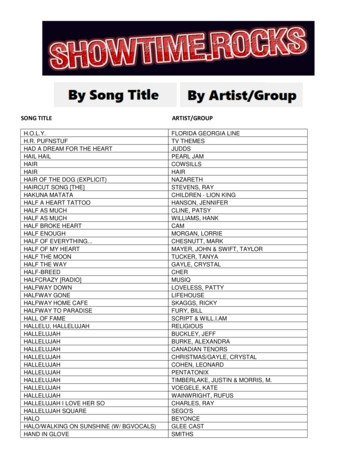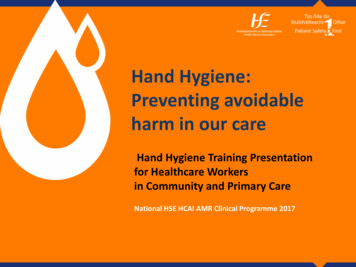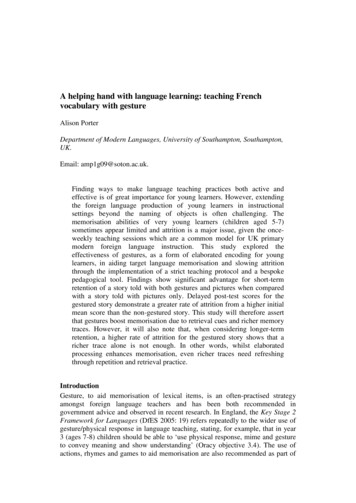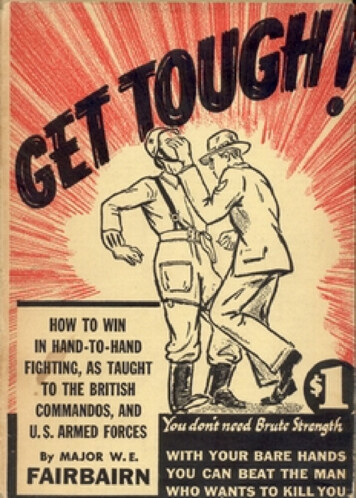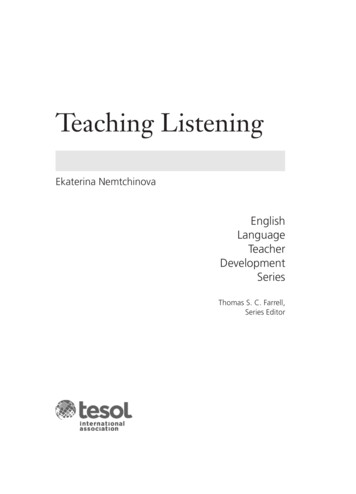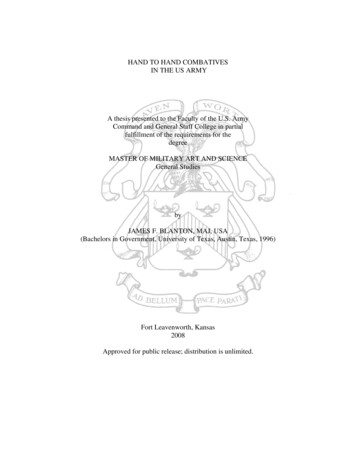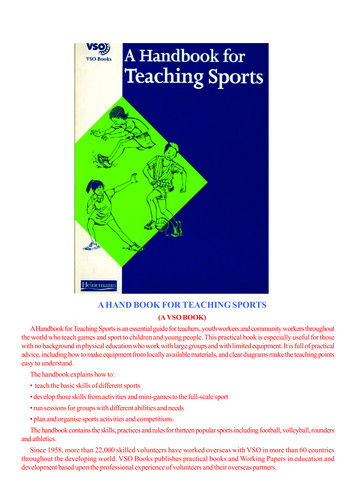
Transcription
A HAND BOOK FOR TEACHING SPORTS(A VSO BOOK)A Handbook for Teaching Sports is an essential guide for teachers, youth workers and community workers throughoutthe world who teach games and sport to children and young people. This practical book is especially useful for thosewith no background in physical education who work with large groups and with limited equipment. It is full of practicaladvice, including how to make equipment from locally available materials, and clear diagrams make the teaching pointseasy to understand.The handbook explains how to: teach the basic skills of different sports develop those skills from activities and mini-games to the full-scale sport run sessions for groups with different abilities and needs plan and organise sports activities and competitions.The handbook contains the skills, practices and rules for thirteen popular sports including football, volleyball, roundersand athletics.Since 1958, more than 22,000 skilled volunteers have worked overseas with VSO in more than 60 countriesthroughout the developing world. VSO Books publishes practical books and Working Papers in education anddevelopment based upon the professional experience of volunteers and their overseas partners.
IntroductionThe importance of sport and physical educationMany people are interested in sports, particularly big events like the football WorldCup, the Olympic Games, and the African Cup of Nations. In schools throughout thedeveloping world, however, teachers face many constraints when they teach sports.Most schools do not have specially trained sports teachers or much equipment, forexample many might only have one football. Students and other teachers might seesports as less important than academic subjects, and even if sport is a syllabus subject,teachers might not have training in how to teach it.By the end of thischapter you shouldbe able to explainwhyphysicaleducation and sportis of value to youngpeople and thecommunity, andunderstand how touse this book.Sport and physical education can improve people’s lives in many ways. Children inparticular will benefit from the opportunities sport can offer. Their experiences will staywith them through their lives and may be passed on to future generations. Sport givespeople the chance to: get together and have fun everyone can enjoy the social aspect of taking part insport whatever their standard or ability experience success and achievement sport gives people the chance to improvetheir personal performances, fulfil their potential, participate in and win competitions keep fit and healthy sport can help physical conditioning, general fitness andwell-being learn physical and technical skills students can learn about the techniques ofvarious sports and how to improve their current skills develop timing, balance and co-ordination sport helps students develop theseskills, which will be useful after leaving school improve mental skills sport and competition encourages people to developproblem-solving and decision-making skills, concentration, determination, control ofemotions and commitment co-operate and communicate with others training and competing with others(particularly in team events) will encourage people to express and share their feelingswith others enhance motivation, organisation, leadership and interpersonal skills sportcan act as a way to develop these skills and take on responsibilities, which can betransferred to other aspects of life in the community.
How to use this bookWho is it for?This sports and physical education handbook is a guide for primary and secondaryschool teachers, and anyone involved with teaching young people sport, for exampleyouth and community workers and refugee camp workers, in developing countries. Youdo not need to have experience of teaching sports or a lot of expensive equipmentin order to use this book. Many of you may have no training in sports, very limitedresources and large numbers of students to teach at one time. This book will help youteach sport whatever your situation. It can either complement a physical education syllabusor serve as a complete guide for teaching sport.How will it help?The book shows you how to teach sports to your students. It explains how to developskills and play games. There are many diagrams and pictures to help you understandthese. The information is very practical and will help you to run sessions that are fun andeducational. It covers many things you will need to know about when teaching sport, andexplains why these are important. Many of you will have different needs and thereforeyou are encouraged to use the information to suit your own circumstances, for examplein terms of resources, number of students, ages and starting levels. Throughout thebook we have used the experiences of and recommendations from VSOvolunteers and their national colleagues, working in schools and with youth groupsworldwide.What areas does it cover?Basic skills are thefoundation skills foralt sports. Students(earn these skillsbefore they attemptmore specific skills.For example, ifstudents cannot catcha large round softball, they will certainlyfind it difficult to catcha rugby ball. Basicskills include: running and jumping throwing and catching hitting and kicking.This book will help you teach your students how to enjoy and play a wide range ofdifferent sports. You might be surprised that the book is not divided into a differentchapter for each sport. The best way to teach sports is through introducing games andskills that relate to certain sports and not by asking students to play a full game of a sportstraight away. This is because students have more opportunity in mini games to practisetheir skills because there are generally less people involved in a smaller playing area. Asa result they are far more likely to enjoy the games and improve their skills.Once your students can master some basic sports skills, you can then go on to teachthem skills that relate more specifically to different sports. You will notice that these aregrouped together into invasive, net, batting and fielding, and athletic games. This is becausethere are many similarities between certain sports. For example, both hockey and footballare invasive team games where one team tries to invade the other team’s territory andscore a goal. Similar skills and tactics, such as running, dodging, passing, shooting anddefending, are used and it is important students begin to understand this as they learnabout sport.
Many of the rules for the various sports include mini versions as wellas the full game. These mini games are extremely valuable because theyhelp students to progress towards playing the full game. They give studentsthe opportunity to learn how to use their skills in a competitive situation,without all the pressures of the full game, such as covering a larger area,remembering more rules, having more choices of who to pass to andwhere. While these games are ideal for children who are learning skills,who are not yet strong enough, quick enough or skilful enough to copewith the full game, you should not be misled into thinking they are onlyfor younger or smaller children: everyone should be encouraged tostart by playing mini games.The largest section of this book shows you how to teach your studentsmany sports activities and games, to help them learn about sport andgive them the opportunity to benefit from all that sport can offer. However,there are also other issues involved with teaching sport that you need toknow. Planning sessions, creating opportunities for participation andcompetition, and the way you teach are all very important. As you mayhave very few resources available, suggestions and advice on how tomake equipment is vital so that your students can enjoy many sports andhave as much involvement as possible in the different activities. This booktherefore covers the following areas: general teaching guidelines on planning, equipment, safety and takingthe session (Chapters 1, 2, 3 and 4) how to teach the basic skills of sport (Chapter 5) how to teach the skills required to play many different sports,including rules for basketball, netball, handball, football, hockey, rugby,volleyball, cricket, rounders, softball, long jump, 100 metres and shotput (Chapters 6, 7, 8 and 9) other useful information on organising competitions, officiating andsetting up clubs (Chapter 10).How can it work for you?Whatever the age or ability of the students you are teaching; thisbook provides suitable games for them to play. It will help your studentsprogress their skills so that they can play and enjoy a simplified/full versionof various sports. The progressions are referred to as stages. By the laststage of a skill, for example for goal-throwing games. Stage 5, 2 versus2 (see pages 62-63), you should be able to introduce students to asimplified version of the relevant sports and also the full version, accordingto the progress and ages of the students. You will find that the descriptionsfor each of the games include details of playing areas, safety and equipmentwhich take into account the constraints of available resources. There arealso diagrams to help you visualise how to play the different games andto highlight major teaching points. The sample session plans show youexamples of how to plan, structure and take sessions, using the activitiesshown. The Teaching points’ boxes suggest key questions and modelanswers.
This book gives you the flexibility of having a comprehensive guide forone particular sport or all of 12 sports, depending on your situation. Itgroups activities and rules for each sport according to type (invasive, net,striking, fielding or athletic games) and there may be subgroups withinthese, for example athletic activities are split into track and field events.This will help you and your students to distinguish similarities and differencesbetween the sports, and learn how skills and tactics from one sport maybe transferred to another.Please refer to the Glossary on pages 158-1 59 for definitions of thekey terms used in this book. In particular, you should check the definitionsof sport, students and teachers, to see how they are used in this book.
1. Planning a sports sessionWhy planning is importantBy the end of this chapter youshould be able to: plan and organise sportssessions plan sessions that are safe,specific to the group and theindividual, and that have clearobjectives make or adapt equipmentfrom local resources.Good sessions in sport do not just happen; they require goodplanning and organisation. Good planning can make all the differenceto the safety, enjoyment and success of a session. Planning is particularlyimportant when you teach large groups, groups with varied abilitiesand ages, and students with whom you are not familiar. It is also vital ifyour access to resources, equipment and space is limited. Time investedin thorough planning is time well spent. It helps you make the most ofyour teaching time and prevents time being wasted on irrelevantactivities.How to planThe following session plans give you examples of how to plan asession. There is more to planning than writing a few ideas on a pieceof paper. Students will be quick to notice if your sessions are poorlyplanned, and they will soon become bored. It is important you includevariety in your sessions and split them into parts, for example warm-up5 minutes, main content 20 minutes, cool-down 5 minutes. This helpsyou to plan time effectively and prevents important aspects of the sessionbeing missed due to lack of time. It is better to prepare too muchrather than too little, providing you do not try to cram everything intoone session. Activities you do not use in one session can be used inothers. Consider the following factors when planning your sessions. Who will be in the sessions? What are the session goals? How will the sessions begin? What activities should be included?Session plan How can the sessions be kept safe?(FIRST SESSION)Date 3.7.98 How will the sessions end?Venue Sunny SchoolTime 2 p.m.To help students learn to throw and catch.Duration 45 minutesGroup Boys and girls, 8/9years Targets, balls, bean bags, quoits, markers.Number in group 40ObjectivesEquipmentOrganisation Warm-up/introduction (5 minutes): three colours game (see page 24, warm-up activities/or youngchildren 1) drawing circles (see page 24, warm-up activities for young children2) run to a mark, draw a circle (as above) with a ball, run back tobase.
Main content (30 minutes - see page 44): 4 minutes - Activity 1, bounce and catch 4 minutes - Activity 2, up and catch 4 minutes - Activity 3, tap and bounce 4 minutes - Activity 4, high bounces 4 minutes - Activity 5, targets 4 minutes - Activity 6, quoits6 minutes - relay game, race to a 15 m line and back white throwing and catching (as forActivities 1 and 2), pass the ball back to the next player in the team.Teaching pointsTEACHING POINTSAsk the studentsFor throwing How do you control your throw?Have a smooth action, watch the ball, follow through with your arm in the direction of the throw,and keep your head steady. How do you throw the ball to make it easier to catch?Throw the ball more slowly, closer to the receiving player and at a comfortable height. How do you throw the ball to make it more difficult to catch?Throw the ball faster/harder, further from your body and higher/lower. Which foot do you step forward with to throw the ball?Step forward with the opposite foot to your throwing arm.For catching How do you prepare to catch the ball?Move your feet into position, watch the ball as it approaches, keep your hands together, How do you soften the impact of the ball?Relax your hands and arms; pull your hands in close to your chest as you catch the ball.Cool down (5 minutes): walk twice around the playing area draw circles activity (see page 24, warm-up activities/or young children 2).Collect all equipmentRecap (5 minutes)Summarise the main teaching points. Ask the students: How many balls did you catch out of 10 throws? Why did you drop the ball? Think of two things you have learned to help you improve your throwing and catching.Safety Check there is enough playing area/or both children and equipment. Injuries - none.
EvaluationStudents need more practice in all the games, particularly in Activities 5 and 6. Manystudents forget to follow through in the direction o/ the target and throw upwards and behindinstead of forward. Reinforce the need to follow through in the direction o/ the target and tokeep the head steady.ObjectivesTo help students learn how to throw and catch in pairs.Equipment Targets, balls, beanbags, quoits, markers.OrganisationWarm-up/introduction (5 minutes): three colours game (see page 24, warm-up activities/or young children 1) drawing circles game (see page 24, warm-up activities/or young children 2) in pairs, roll the ball to your partner, your partner catches the ball, run to change placeswith your partner, and then repeat from the opposite position, your partner rolls the bad andyou catch.Main content (30 minutes): 10 minutes recap on Activities 1-6 as for Session 1; try to improve on scores from lastweek’s session.Games for two 4 minutes - Activity 1, throw and catch 4 minutes - Activity 2, rugby catch 4 minutes - Activity 3, high and low 4 minutes - Activity 4, catch and run 4 minutes - relay game, play games 5 and 6 from session 1 as a relay,- the first team toreach three points is the winner.Teaching pointsTEACHING POINTSAsk the studentsFor throwing How do you vary the height?Imagine throwing over or under something. Where do you throw the ball if your partner is moving?Look for an indication from your partner; throw the ball in front of the body.For catching How can you prepare for the catch?Move your hands and feet into position, keep your head still.
Cool down (5 minutes.): skip slowly /or approximately 20 m, jog back, repeat stretch tall, crouch small, repeat.Collect equipmentRecap (5 minutes)Summarise the main teaching points. Ask the students: Did you find any improvement from last week? What was better? What did you still find difficult? What do you need to practise?Safety Check there is enough playing area/or both children and equipment. Injuries - Austen/ell over, small graze on knee.EvaluationStudents improved on activities from Session 1 but found new activities harder;they need more practice, particularly on game 4 (games for two).Who will be in the sessions?Before you plan the activities in your session, it is important to think about thestudents you are teaching. You can then prepare the sessions according to theirneeds and level of experience. The following examples show the sort of informationyou will need to know. How many students will be attending your session?This helps you to visualise if there is enough space or equipment to carry outcertain activities. Make sure you can adapt activities/sessions for more or fewerstudents, in case exact numbers do not arrive. What is the ability and experience of the students you are teaching?Volunteers andcolleagues suggest youencourage students in awheelchair to use acloth frisbee instead ofa ball for throwing andcatching: they shouldfind this easier andmore fun. The frisbeecan be made by plaitingcloth and sewing ittogether at the edges.For example are they complete beginners? Do they take part in any sport activitiesin or out of school? Are some students more experienced and skilful than others? What is the range in terms of physical and mental maturity of the group?Sometimes age can be misleading as students develop at different rates, particularlyin terms of size and strength levels. Are there boys and girls in the group?Some activities may need to be adapted for mixed groups. What are the needs of the group?Some groups may need more encouragement, guidance or time to practise thanothers.Students with special needs can be involved in many of the games in this book,with some modifications. You should always include them in the main activity, unlessthere is a more appropriate game they can play. The students will tell you what theycan or cannot do and you can then plan and adapt the session accordingly. You willhave your own ideas on possible modifications to games or equipment.
What are the session objectives?Planning helps you and your students to achieve objectives and ambitions. These objectivesmay be ones of enjoyment, participation or improving skill. Consider what the students want togain from the sessions, as well as what you would like them to achieve, and then jot down themain objectives for each session. This has been done in the example session plans (see pages 9and 11). Once you have clarified these, you can then plan the sessions so they include activitiesto help the students achieve group and personal targets. You are recommended to set objectivesbecause it: helps you stay focused on what you and your group want to achieve gives you a basis on which to evaluate the session motivates you and your group to achieve targets helps you and your group to interact and creates a team effort provides opportunities for your students to experience success that will lead to greaterenjoyment and self-confidence.Setting objectives can hinder progress if they are not thought out carefully. For example, ifyou tell students they ‘must’ perform a certain skill by the end of the session, they may well reactnegatively to the pressure of this target. Listed below are some useful hints to help you seteffective objectives for your session (with examples to show you how you would use theseguidelines to improve the speed of your students). Try to ensure the objectives you set are‘SMARTER’: Specific For example for students to improve speed over 30 m. Measurable: For example for students to decrease individual times by half a second. Agreed with your students Realistic For example explain to students that some will improve their time more thanothers; each student may aim to decrease their time by more or less than half a second. Time-framedFor example for students to reach their target by Session 4. ExcitingFor example explain how running faster will improve their sport. Recorded Make a note of progress so students can see improvements.How to begin the sessionsThe start of each session is very important. It can affect students’ attitudes towards learning,their enthusiasm, and their desire to have fun. It is often helpful to recap on the events andlearning from the previous session. Ask the students what they remember! If they have beenpractising their skills since the previous session, you should acknowledge their efforts. In addition,you should try to: help groups relax explain the objectives of the session motivate groups to enjoy the activities and progress their skills prepare groups physically for exercise.
What activities should be included?When you plan your sessions, consider the following factors. Are the activities varied but simple, challenging but achievable, fun but productive? Do they cater for the needs of the groups and individuals within the groups?Planning the content of a session should be straightforward, once the objectives areestablished. The activities and exercises you choose should help those you teach to achievetheir targets. Experiment with new ideas so you can add to your range of activities. This willhelp you provide variety for your groups and keep them motivated. For instance, whenplaying any sport you can always change the emphasis by making students play undercertain conditions. In basketball, for example, if you want to encourage students to scoregoals using the backboard, you could make a condition that only goals having touched thebackboard will count.As a general rule, your sessions should include a combination of reinforcing what studentsalready know or can do new skills or challenges, and competitive opportunities. You shouldalso note that students really appreciate and respond positively to a final exercise that isbased upon fun and games rather than a technical skill.When planning sessions for young children, you should: make sure your activities are suitable for their age, physical development and skill level change the form of the game to fit the children, for example modify the rules, equipment,court size, so that they can cope with the task make sure there are frequent breaks so that they can have a rest and a drink make sure you vary the exercises and keep each one short; young children get boredvery easily and do not concentrate for very long on one activity teach them what they need and enjoy, as well as what you want them to learn.RECOMMENDATIONS FROM VSO VOLUNTEERS AND THEIR NATIONAL COLLEAGUESECOMMENDATIONS FROM VSO VOLUNTEERS AND THEIREEKLKLATIONAL COLLEAGUESFOR ENCOURAGING EVERYONE TO TAKE PART Increase the options available, particularly for those who are not in teams, for example skill exercises or simple,fun games. Introduce new sports such as volleyball, basketball or softball. Introduce skills award schemes to motivate students by rewarding progress. Run competitions and present small prizes to winners and to those with other achievements, such as best effort,most improved player, fairest player. Encourage parents to support their children by coming to watch them in competitions. Give students leadership positions when working in groups. Give talks about sports heroes and personalities. Take students to watch a sporting event. Choose games that include fun, challenge and excitement. Recognise and praise achievement and effort during practices.
FOR ENCOURAGING GIRLS SPECIFICALLY TO TAKE PART Choose games that do not have an image of being gender specific, such as volleyball. Play with mixed teams of boys and girls, particularly in traditionally male-dominated sports such as football. Let them play and show you some o/ the games they are already familiar with. Let them take part in activities they enjoy, for example, keep-fit, rounders. Organise activities around the responsibilities many of the girls have in the home after school. Allow girls to wear clothes in which they feel comfortable. Promote sport to girls by using their pictures in publicity materials. Try to encourage community awareness of the benefits girls can experience from sport, for example, it can help toincrease their confidence. This will help girls to feel that it is more socially and culturally acceptable/or them to playsport.FOR WORKING WITH LARGE NUMBERS Begin with a warm-up that is /un and will involve everybody. Divide the class into two with one group playing one game and the second group playing another. Ensure that each group includes some students who are more experienced and know the game well. Provide any students sitting out o/ the game with a ball so they can practise throwing and catching. Play rounders - this uses large groups and involves everyone. For demonstrations and warm-up exercises, stand with the group in a semi-circle around you. This means thateveryone can see and hear you clearly and you can see them clearly too. Play winner stays on in games such as football or netball so when a team scores, the other team goes off andanother comes on; this allows all students an opportunity to play. Play small games such as 4 versus 4 in netball using a smaller area such as a third of the netball court; this allowsmore games to take place. Divide the group into smaller groups and nominate a student to be the group leader.FOR WORKING WITH DIFFERENT ABILITIESIntroduce new rules to your existing games to help students with less skill still enjoy competing with those who aremore skilled. For example in games where the aim of the exercise is to score goals, you could introduce the followinghandicapping system: students with less skill score three points for each goal; those who are average score two points/or each goal; and those who find scoring goals relatively easy, are only given one point for each goal.STUDENTS WITH SPECIAL NEEDSWorking with students who have special needs is very rewarding, providing you understand their needs and/eelconfident of making the sessions work/or them. Most important, you must make sure students with special needs/eelintegrated with everyone else in the session and are always included in decisions and activities, even though you mayhave to make some adaptations. To do this, you need to find out more information. For example. What is the nature of their disability? What does this mean in terms of abilities and limitations?
What does this mean in terms of communication? What are the needs of the student and how can you help to fulfil these?(A useful book is ‘Working with Disabled Sportspeople’. You can obtain it from Coachwise Ltd, 114 CardiganRoad, Headingley, Leeds LS64JQ, UK.)How to keep sessions safeIn sport, accidents do sometimes happen, and teachers have a responsibility to try to stop them occurring. Sessionsshould start with a warm-up and finish with a cool-down to reduce the risk of injury (see Chapter 3). The following listshows you examples of safety aspects that you should consider at all times throughout the planning phase. You shouldcheck: for obstacles or potential hazards, for example dangerous surfaces whether there is enough playing area for the number of children in the group that any equipment needed for the session is in safe working order the location of medical aids for example first aid kit, water, the nearest medical adviser/official, clinic/health centreor first aid worker. if any students have a specific medical condition, for example epilepsy, diabetes safe drinking water is available activities are managed, controlled and officiated properly students do not dehydrate look out for signs of faintness.One of the most common hazards in sport is people colliding with each other, particularly with large numbers andactivities that involve running and chasing. You will find it helpful in many activities you teach to use grids. A grid is aplaying area that is sectioned off by using four markers, one in each corner. You can give groups of students their ownarea in which to do activities but ensure that everyone stays within their own grid. This helps to use space efficiently andprevent students colliding with each other.How to end the sessionAt the end of the session, always try to recap on what your groups have achieved. This reinforces progress andlearning. Being positive at the end of your sessions will help to encourage students to practise some of their skills andlook forward to the next session. You should ask your groups to help you clear away any equipment. Encourage themto drink plenty of water after the session as the body loses a lot of fluid during exercise. To prevent muscle soreness andinjury, your groups should cool down (see page 26) at the end of each session and you should allow some time(approximately 5 minutes) for this when you plan your sessions.After the sessionOne important stage often overlooked by teachers is evaluating a session or course of sessions. This is importantbecause it forms the basis of future planning. It helps you to evaluate your progress as a teacher, as well as giving youfeedback on the progress of your groups. Make notes as soon as possible after the session so that you have anaccurate record. Your comments should include: what went well and why what went badly and why what improvements you can make to your sessions
what changes you need to make to your next session, for example in terms of planning and equipment what the students enjoyed/disliked how the students behaved/responded/contributed how well the group achieved its objectives how individuals achieved their objectives; you should make a note of those who made good progress and thosewho need extra h
VSO Books publishes practical books and Working Papers in education and development based upon the professional experience of volunteers and their overseas partners. . While these games are ideal for children who are learning skills, who are not yet strong enough, quick enough or skilful



